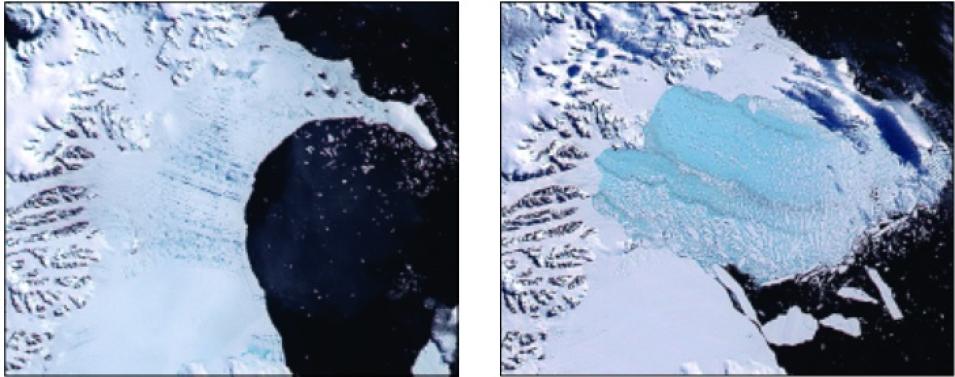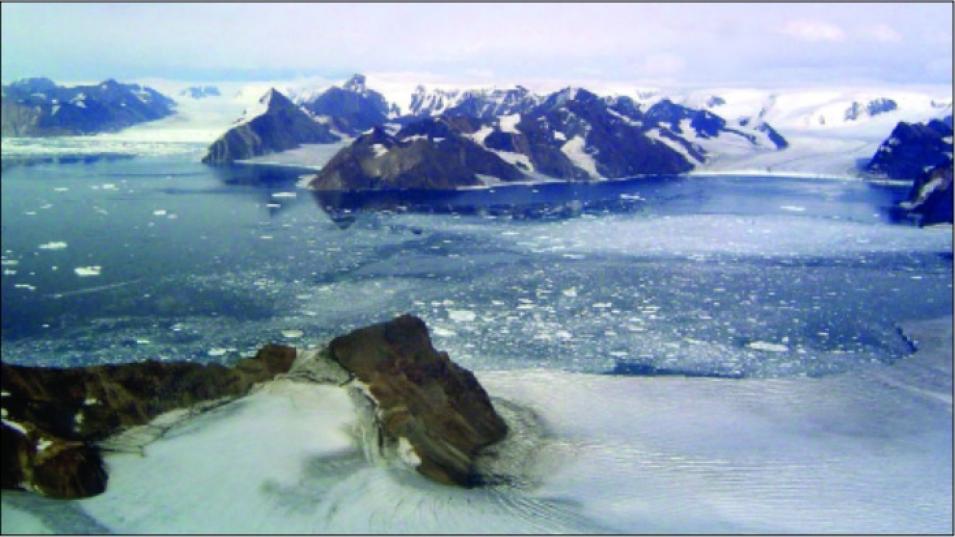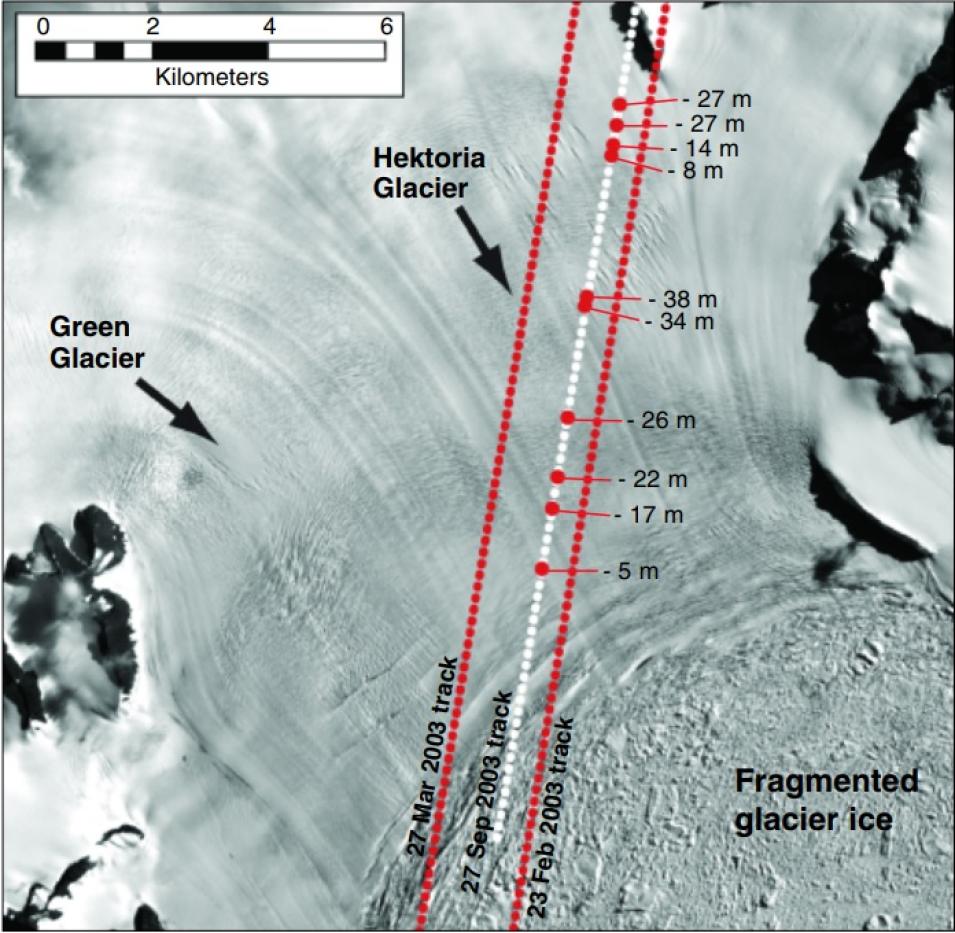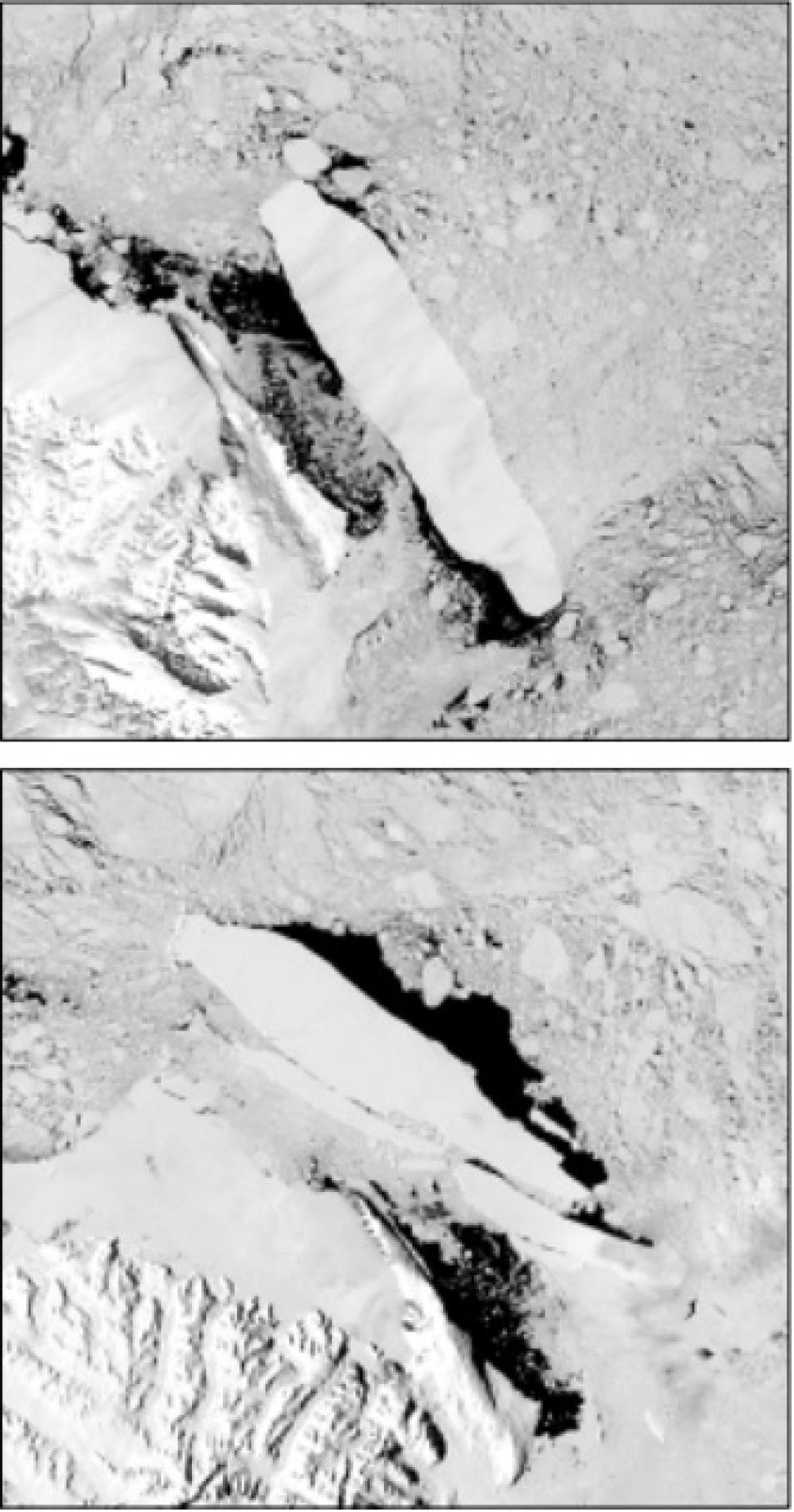Peril an ocean away
While researchers have since learned more about the role of melt water and the effects of glacier acceleration in ice shelf dynamics, and the potential for global sea level change, the Larsen B collapse spurred researchers to develop additional theories about how and why ice shelves collapse. They learned that surface melting is only part of the story.
Douglas MacAyeal, at the University of Chicago, is pursuing a culprit that may come from halfway around the globe: ocean swells. The swells he studies are not picturesque white-capped ocean waves, but long, low, storm-generated swells that can travel for thousands of miles.
MacAyeal said, “You wouldn’t see them if you were out on the ocean, because they would have a kilometer [0.62 mile] wavelength. They’re very long.” The swells also have a low amplitude, or height, of only a few centimeters (less than an inch), making them difficult to detect without sensitive equipment. MacAyeal and his colleagues discovered the effect of these waves after an iceberg they were studying, named B-15A, abruptly shattered on October 27, 2005. B-15A was a large iceberg, about the size of Luxembourg, which had run aground off of the coast of Antarctica.
It broke up on a calm day with locally mild weather, puzzling observers. MacAyeal and his colleagues retrieved a seismometer that they had previously installed on the iceberg and analyzed the data. They discovered that just before the breakup, the seismometer recorded long, low swells that had rocked the iceberg and pounded it against the coast. MacAyeal traced the swells back to a surprising source—a giant winter storm off the coast of Alaska five thousand kilometers (eight thousand miles) away.
Even the surrounding sea ice, which usually absorbs ocean wave energy, had not protected the iceberg. “Sea ice does keep the waves from propagating if the wavelength is short, less than 100 meters [328 feet]. But these waves are so long that they just flex the sea ice,” MacAyeal said. This lack of protection could have serious consequences for ice shelves, as well as icebergs. However, these long, low swells do not act alone. “Melt water tends to fracture the crevasses and produce an ice shelf that’s broken up but hasn’t fallen apart yet,” MacAyeal said. “It’s like an old house where the mortar has come out from between the bricks but the bricks are still stacked. If the ice shelf has warmed up and weakened over a long period of time, then the next storm that comes along whacks it. It’s the waves that shake the pieces apart.” Scambos agreed, saying, “There are a lot of things happening together to cause a catastrophic ice shelf breakup, but these long-wavelength swells may be doing some of the dirty work.”
Like Glasser, MacAyeal also plans to look back in time to see if there is a connection between distant storms and previous ice shelf retreats or collapses. For instance, he is investigating the calving of iceberg B-15, the parent iceberg to B-15A. MacAyeal said, “When B-15 broke off the Ross Ice Shelf in 2000, it was thought to have been a time when there were lots of waves being recorded.” Storm-generated ocean waves are just one of many environmental triggers behind ice shelf collapse that scientists are trying to understand. And while such triggers may not contribute directly to rising sea levels, they do indicate a larger connection between global weather and the long-term stability of Antarctica’s ice masses.
The future of Antarctic ice
The long-term response of the glaciers behind the Larsen B remnant remains unknown, and continues to be an object of study. Scientists like Scambos, Shuman, Glasser, and MacAyeal are watching the Antarctic Peninsula with keen interest, observing both the post-collapse glaciers and the remaining ice shelves. Glasser said, “So far, the glaciers thin, accelerate, and recede, discharging more and more ice into the ocean each year. If you’re a glacier, that’s a pretty bad recipe.”
Accelerating glacier ice is an unwelcome ingredient in the recipe for global sea-level rise, making it important for scientists to understand the factors behind ice shelf breakup. As long as the massive Antarctic ice sheets remain locked away behind ice shelves, doled out in an occasional iceberg, sea level may remain stable. But if warming and melting trends persist, more ice shelves may begin to show the same signs of weakness observed in the Larsen B ice shelf before it disintegrated. “This problem of sea-level rise is a real one,” says Scambos. “It’s likely to happen, and the steps could proceed more rapidly than we thought.”
References
Cook, A. J., A. J. Fox, D. G. Vaughan, J. G. Ferrigno. 2005. Retreating glacier fronts on the Antarctic Peninsula over the past half-century. Science 308(5721): 541–544, doi:10.1126/science.1104235.
MacAyeal, D. R., E. A. Okal, R. C. Aster, J. N. Bassis, K. M. Brunt, L. M. Cathles, R. Drucker, H. A. Fricker, Y. J. Kim, S. Martin, M. H. Okal, O. V. Sergienko, M. P. Sponsler, and J. E. Thom. 2006. Transoceanic wave propagation links iceberg calving margins of Antarctica with storms in tropics and Northern Hemisphere. Geophysical Research Letters 33, L17502, doi:10.1029/2006GL027235.
NASA Goddard Institute for Space Studies. Sea level rise, after the ice melted and today. https://www.giss.nasa.gov/research/briefs/gornitz_10/. Accessed October 3, 2007.
Scambos, T. A., J. A. Bohlander, C. A. Shuman, and P. Skvarca. 2004. Glacier acceleration and thinning after ice shelf collapse in the Larsen B embayment, Antarctica. Geophysical Research Letters 31, L18402, doi:10.1029/2004GL020670.
For more information
NASA Land Processes Distributed Active Archive Center (LP DAAC)
NASA National Snow and Ice Data Center DAAC (NSIDC DAAC)
Advanced Spaceborne Thermal Emission and Reflection Radiometer (ASTER)
Ice, Cloud, and Land Elevation Satellite (ICESat)
Landsat
Moderate Resolution Imaging Spectroradiometer (MODIS)
NASA Earth Observatory: Fragment of its Former Shelf
| About the remote sensing data |
| Satellites |
Terra |
Terra and Aqua |
Ice, Cloud, and Land Elevation Satellite (ICESat) |
| Sensors |
Advanced Spaceborne Thermal Emission and Reflection Radiometer (ASTER) |
Moderate Resolution Imaging Spectroradiometer (MODIS) |
Geoscience Laser Altimeter System (GLAS) |
| Data sets |
ASTER L1A Reconstructed Unprocessed Instrument Data |
MODIS Mosaic of Antarctica |
GLAS/ICESat L2 Antarctic and Greenland Ice Sheet
Altimetry Data |
| Resolution |
15, 30, or 90 meters |
125 by 125 meters |
60-meter spots separated by 172 meters |
| Parameters |
Land ice |
Land ice |
Elevation |
| DAACs |
NASA Land Processes Distributed Active Archive Center (LP DAAC) |
NASA National Snow and Ice Data Center DAAC (NSIDC DAAC) |
NASA NSIDC DAAC |



